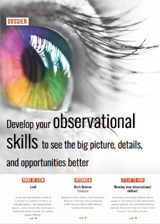Innovation, agility, customer and employee centricity – your navigation of each and every one of these leadership challenges begins with observation. To help you develop your observational skills, here is James Gilmore’s simple, concrete method: “The Six Looking Glasses”!
Seeing the big picture, paying attention to small details, and spotting new opportunities are all critical leadership imperatives. According to co-founder of the executive learning consultancy Strategic Horizon, lecturer at the University of Virginia, and author James Gilmore, these different capabilities are just different parts of one whole: your observational skillset. To help you become a more well-rounded and skilled observer, Gilmore offers a simple, concrete approach that he calls the “Six Looking Glasses” method. The basic idea of Gilmore’s method is to switch between six different observational approaches depending on your objectives. His “looking glasses” metaphor is meant to convey that different kinds of looking call for different “viewfinders.”
Use binoculars to see the big picture
Seeing the big picture is important when deciding how to direct your teams, particularly when your time is limited and you have to decide quickly where to invest more resources. Looking at the big picture is also helpful whenever you enter new and unfamiliar terrain, or when your situation or context undergoes change. Like when you use binoculars, looking at the big picture is about stepping back to survey and scan the entire scene from a distance. In any observational mission, this type of looking is meant to help you determine what merits deeper consideration and examination. Gilmore warns against two common errors: scanning too quickly and failing to focus your attention. “Don’t sweep across the scene so rapidly that nothing in particular comes into focus,” he writes. “We mistakenly associate focused attention only with looking up close and in detail. Not so! Binoculars looking also requires attentiveness. It’s just being attentive at a distance. Rather than fixing attention on a single object, its function is to see everything that is out there.” He recommends looking at the big picture at the start, middle, and end of any observational mission.
Feel like you’re missing something? Try bifocals
As opposed to surveying and scanning the whole scene, sometimes you also need to compare and contrast different individual aspects. This type of looking to compare and contrast is useful when you want to combat confirmation bias. It can also help you see “noteworthy anomalies that you would otherwise not notice” because of any dominant paradigms that could be obstructing your viewpoint. Whenever you catch yourself looking at a situation or problem in an automatic, comfortable manner, Gilmore tells you to don your “bifocals.” This process takes the form of picking two different viewpoints, and then looking with first one and then the other to compare and contrast what you see.


